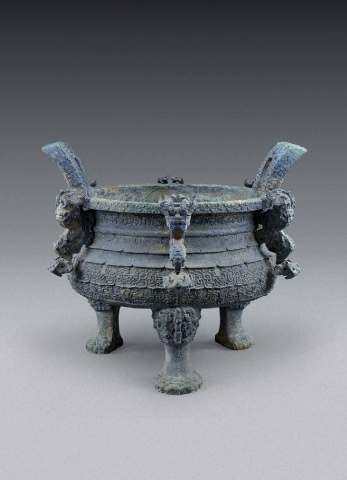Page 201 - Deydier VOL.2 Meiyintang Collection of Chinese Bronses
P. 201
199. Ritual bronze food vessel ding (shengding)
Eastern Zhou dynasty, late Spring and Autumn period, circa 6 century bc.
th
東周春秋晚期青銅升鼎
Height: 53 cm, Diameter: 64.5 cm
An exceptional archaic bronze food vessel ding supported Provenance:
by three stylized animal-shaped legs. The vessel’s flat- ▪ The Wang Collection, Taipei, Taiwan.
bottomed body is cast with four rows of U-shaped ▪ Christian Deydier/ Oriental Bronzes Ltd, London, U.K.
scale motifs, each of which is decorated with a motif of ▪ The Peter Kwok Collection (Dong Bozhai), Hong Kong.
intertwining stylized dragons. From the outer upper ▪ Galerie Christian Deydier, Paris, France.
sides of the vessel emerge six large dragons cast in the
round with powerful ornate horns. From the vessel’s Exhibited:
thick-lipped rim emerge two elaborate, portal-shaped, ▪ Biennale des Antiquaires, Paris 2002, Christian
outwardly leaning handles decorated with intertwining Deydier - Oriental Bronzes Ltd.
stylized dragon patterns. ▪ Chine de Bronze et d’Or, Collection Dong Bozhai,
Musée du Président Jacques Chirac, Sarran, 2011,
The upper part of each of the vessel’s legs is cast with catalogue no. 14.
intertwining dragon motifs forming a kind of taotie mask ▪ Trésors de la Chine ancienne, Bronzes Rituels De La
in low relief.
Collection Meiyintang, Musée des arts asiatiques
Guimet, Paris 13 mars - 10 juin 2013, catalogue no. 90.
The vessel has an exceptionally attractive light blue
patina.
Published:
▪ Béguin G., Chine de Bronze et d’Or, Collection Dong
Bozhai, Musée du Président Jacques Chirac, Sarran,
2011, p. 102 - 105, no. 14.
▪ Guimet, Musée des arts asiatiques, Trésors de la
Chine ancienne, Bronzes Rituels De La Collection
Meiyintang, Paris 2013, p. 148 - 149, no. 90.
Notes:
▪ This exceptional bronze vessel possesses all the
characteristics of a major bronze cast at the end of
th
the 6 century bc. by the artisans of the Kingdom of
Chu, the producer of the most sophisticated and high
quality bronze vessels cast in China during the Spring
and Autumn and Warring States periods.
▪ The present vessel is, in its casting, its decoration and
its quality, very similar to the pieces excavated in 1978,
from tomb M2, near the Dan river, in Xichuan Xiasi,
Henan province. Among the five hundred bronzes
excavated from this tomb, a great number of which
bear inscriptions mentioning Prince Wu, archeologists
discovered a set of seven large bronze ding of a height
of between 61 cm and 68 cm, and a diameter of
between 58 and 66 cm. These ding vessels, known as
the Wang Zi Wu sheng ding 《王子午升鼎》or “ding
vessels of Prince Wu” are extremely similar in their
shape, casting and decoration, to the present ding.
From what is known of the life of Prince Wu, the dings
can be dated to between 575 and 550 bc.
▪ In view of the above, it is certain that the present
ding was owned by a very important member of the
Chu aristocracy and was cast in the middle of the 6
th
century bc.
200
200
200
200
200

